Content
- 1 Garden beds for cold and rainy regions
- 2 Harvest in the highest beds in cold and rainy climates
- 3 Cucumbers in tall beds in cold climates
- 4 Growing tomatoes in high beds in the cold and rainy climate of the Leningrad region
- 5 Growing peppers and eggplants in the Leningrad region
- 6 Growing melons in the Leningrad region in high beds. Grafted melons
- 7 Growing watermelons in the open field. Leningrad region
- 8 The best self-pollinated cucumber varieties for the Leningrad region
- 9 Greenhouse varieties
- 10 For open ground
High beds. Growing in the north of cucumbers, tomatoes, peppers, eggplant, watermelons, melons. Vaccinations of cucumbers and watermelons for lagenaria to increase yields. Grafted melons.
When laying a garden on a personal plot, most gardeners think about what vegetable and berry crops they would like to grow, many study information on varieties and agricultural technology. But most hardly think about what beds should be in their garden.
Speaking about the beds, I mean not only their length and width, but also about their height.
On the Internet, specialized magazines and books, you can find many ways to plant plants. But how to understand what exactly your garden needs?
First of all, I proceed from the climate and groundwater level.My vegetable garden is located in the north of the Leningrad region, in a lowland, in a former swamp, with a high level of groundwater.
After reading various articles on growing vegetables on the Internet, as well as various specialized literature, I noticed a pattern - the warmer the region, the more people make the beds lower, or plant them on a flat surface, or make beds below the soil level, in "ditches".
In the south, it turns out, it is important not to warm up the soil, but rather to cool it. And in my northern region, the main factor of crop failures is the lack of heat. How to give the plants the warmth they lack?
Many gardeners know and apply in practice "warm ridges". Most often these are beds 30 cm high, under the bed, the earth was also removed on the bayonet of a shovel. Organic debris, grass, hay, manure were laid at the bottom and covered with a layer of 20 cm of earth on top. I also did so and planted thermophilic tomatoes, cucumbers and peppers. The plants liked it, the harvest, in comparison with previous years, pleased. But the next summer, in addition to the cool weather, we were flooded with rains. The harvest was bad. I tried to understand: what is wrong?
Garden beds for cold and rainy regions
I came to the conclusion that I need to give my plants as much heat as possible and protect them from the harmful effects of excess moisture... Low beds, with a large amount of precipitation and high groundwater, accumulate too much excess water, the decomposition of organic residues slows down or stops altogether, plants do not receive heat, roots in cold, wet soil begin to die off. How to fix it? After all, you can't hide the whole garden under the roof?
The solution turned out to be quite simple - to increase the height of the beds. Now I have for ordinary crops (beets, onions, garlic, rutabagas, potatoes, strawberries) -beds 30 cm high, and under thermophilic (cucumbers, tomatoes, eggplants, peppers, zucchini) - beds 60cm high... And just under the cucumbers I in the spring I lay horse manure, make a "warm bed", you can read about it - HERE... For the rest of the crops, the warmth that tall beds accumulate in a day is enough.
Harvest in the highest beds in cold and rainy climates
Various vegetables and berries grow and develop beautifully on these beds.
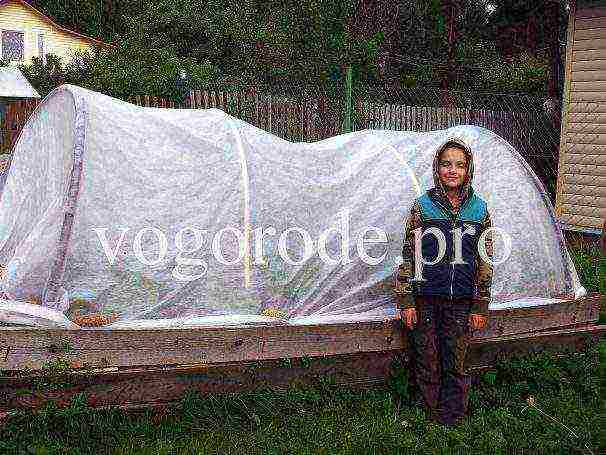 Beds for ordinary crops with a height of 30-45 cm
Beds for ordinary crops with a height of 30-45 cm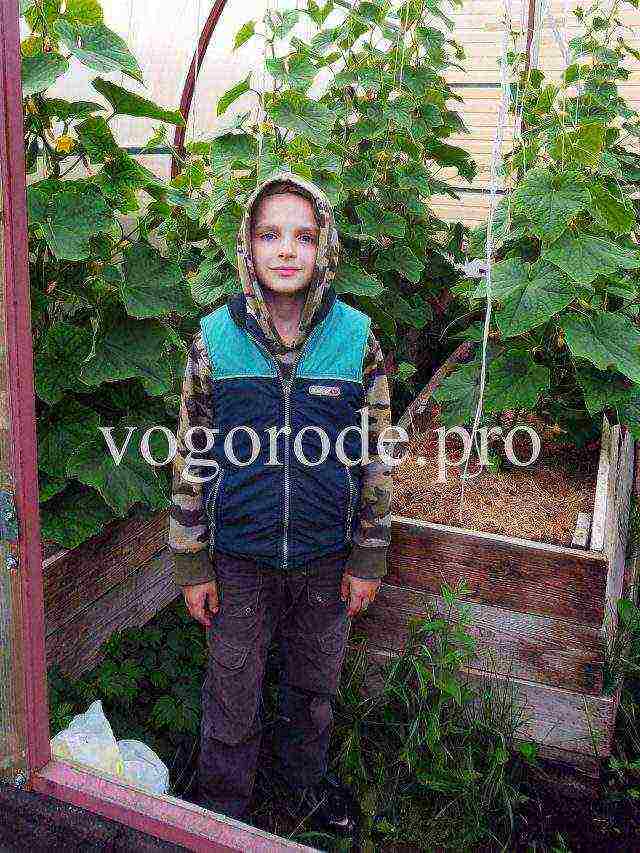 Beds in a greenhouse, for thermophilic crops (cucumbers, tomatoes, eggplants, peppers) - 60 cm high.
Beds in a greenhouse, for thermophilic crops (cucumbers, tomatoes, eggplants, peppers) - 60 cm high.
First of all, after moving to such high beds, I saw a significant increase in the yield of cucumbers and tomatoes in greenhouses. Cucumber plants grew faster and yielded more. Plants have ceased to suffer from such an unpleasant disease as root rot, which appears during rainy and cold weather. And most importantly, I was able to plant them much earlier and, accordingly, get an earlier harvest.
Cucumbers in tall beds in cold climates
For example, this year I took off the first cucumbers at the end of May, on average, depending on the weather, the first cucumbers appear in the first ten days of June without any additional effort on my part. Although earlier I had to install an additional film cover over the cucumber seedlings and additionally cover the ground with a film so that at night the soil does not give off heat so quickly. It was not difficult while I lived there from April to October, but when the children went to school, we only started coming in the spring for weekends. With such a shelter, in a "warm bed" filled with horse manure, on hot days, unattended, the planted plants could simply "burn out" and die.
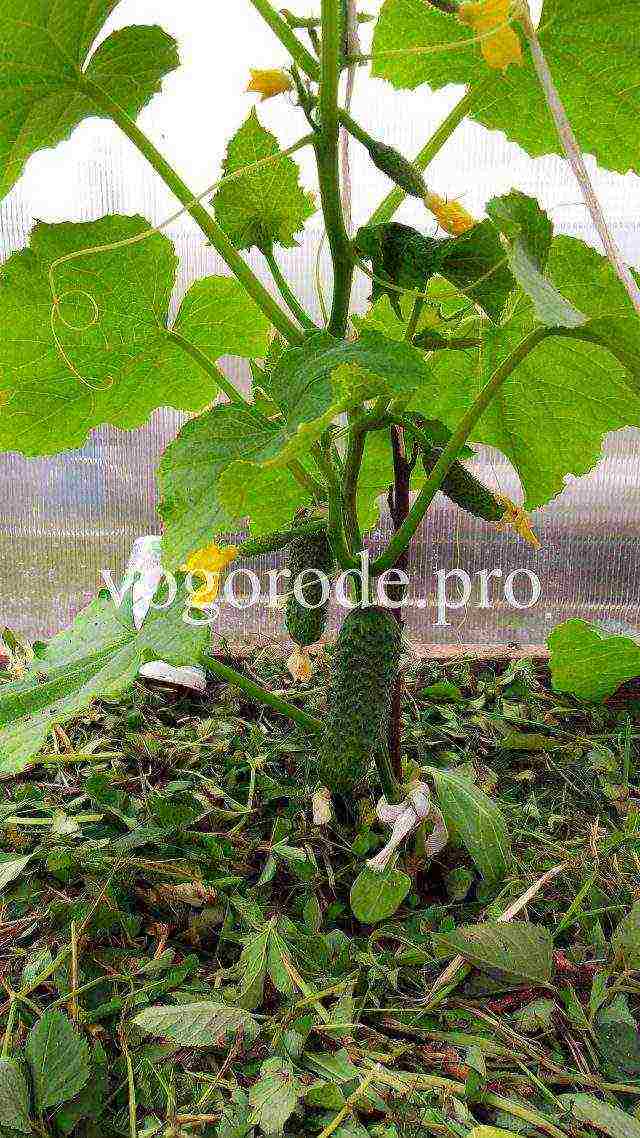 On May 29 it is very pleasant to eat your own cucumber grown in the Leningrad region.
On May 29 it is very pleasant to eat your own cucumber grown in the Leningrad region.
To increase cold resistance and increase yields, I additionally use this technique, as a grafting of cucumber plants on a stock - lagenaria. The grafted plants give the first harvest about 3 weeks earlier than the unvaccinated ones, do not get sick and better tolerate the changes in night / day temperatures, which are typical for the Leningrad region and the northern regions. Lagenaria is resistant to cold snaps, low soil temperatures, its root system is much more powerful than cucumber.
"Vaccinations of cucumbers" - photos and videos, you can watch HERE.
In more detail, about growing grafted cucumbers, I will tell you - HERE
Growing tomatoes in high beds in the cold and rainy climate of the Leningrad region
As for tomatoes, the increase in yield was very encouraging, and most importantly, there are always a lot of them, regardless of the amount of rain. After all, everyone knows that the main enemy of tomatoes is moisture. Tomatoes do not tolerate excess moisture in the soil and air, they begin to hurt, incl. such a terrible disease as late blight, and the entire crop perishes in the bud.
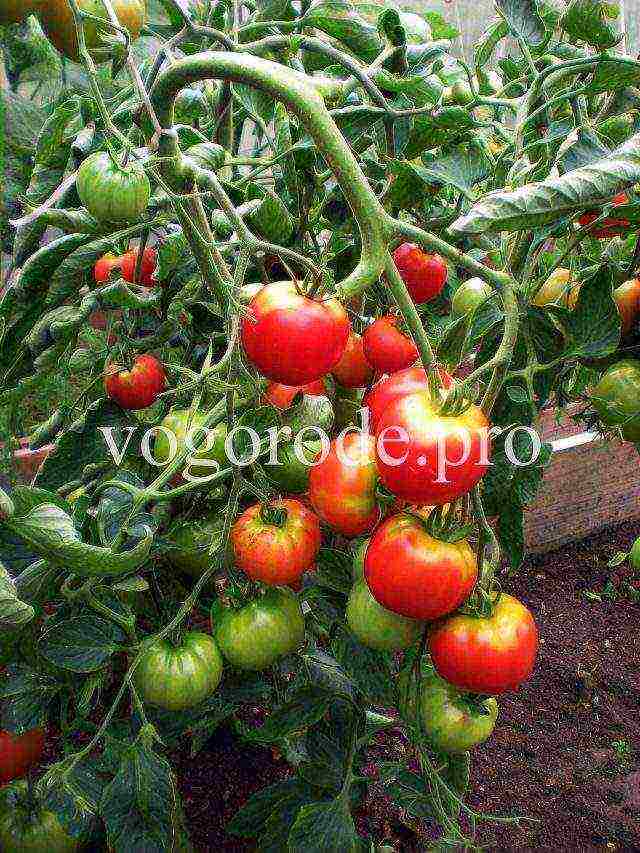 In such high beds in our cold climate, the number of ovaries on tomatoes has increased significantly
In such high beds in our cold climate, the number of ovaries on tomatoes has increased significantly
In addition to the increase in the number of tomato ovaries, their size has also increased.
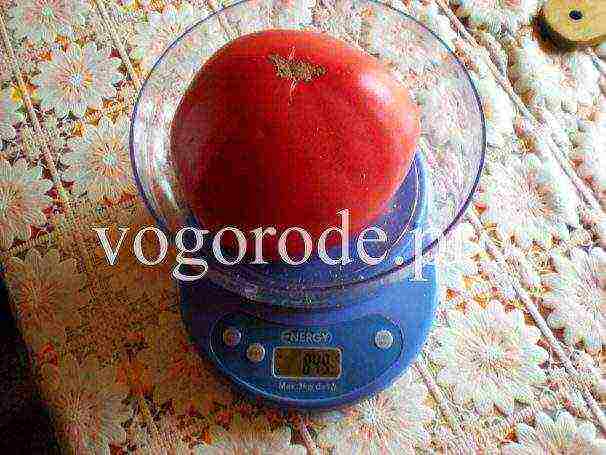 So, for example, tomatoes of the Pink Honey variety reach up to 700-900 g, and these are not single tomatoes, but most of the fruits from the bush.
So, for example, tomatoes of the Pink Honey variety reach up to 700-900 g, and these are not single tomatoes, but most of the fruits from the bush.
And most importantly, they always ripen! I do not remove green tomatoes and put them to ripening. My tomatoes are ripening on the bush! And when growing tomatoes I manage without such laborious work as creating a "warm bed". "Growing tomato seedlings in the Leningrad region" - HERE.
«Growing early tomatoes in a greenhouse in the Leningrad region. Harvest in June "- HERE.
Growing peppers and eggplants in the Leningrad region
Honestly, while I had low beds in the greenhouse, I practically did not plant eggplants and peppers. I tried it several times - the harvest was ridiculous to tears. Despite the fact that the seedlings need to be grown at home for several months, then transported to the dacha, a couple of eggplant fruits and a few peppers did not impress me. In eggplants and peppers, with a good development of the leaf mass, the flowers fell off all the time, in bad weather even the ovaries that began to grow could fall off.
When I made tall eggplant beds, the harvest impressed me so much that I realized that eggplant can be grown in the north!
Now it is enough for my family to plant only 4 eggplant bushes - it is enough for us to eat fresh, and to make preparations for the winter!
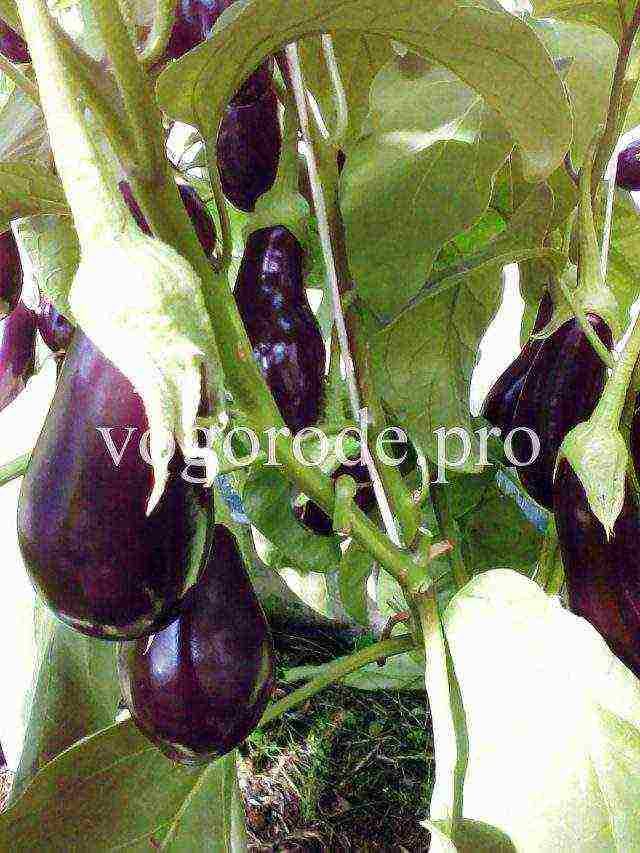 Eggplant harvest in a very high garden bed in the Leningrad region
Eggplant harvest in a very high garden bed in the Leningrad region
Besides cold, rainy weather, our region is famous for its white nights. And in all the literature on agricultural technology of eggplants it is written that they are short-day plants. Even having planted them on a high bed, I doubted whether they would grow? Shouldn't they also arrange a "warm bed" with horse manure? Shouldn't they be covered with a black cloth at night?
In 2012, I read the article “We grow eggplants ", and now, having very tall beds and forming plants - opening flowers to the sun, as advised in the article, I have excellent yields. I no longer have such problems as falling flowers and ovaries.
Growing eggplant seedlings. Care, formation, pinching of eggplants in the greenhouse of the Leningrad region - HERE
Growing melons in the Leningrad region in high beds. Grafted melons
After experimenting with cucumbers and tomatoes, peppers and eggplants, when I was confident that such beds would not let me down, I decided and planted melons and watermelons for a test.
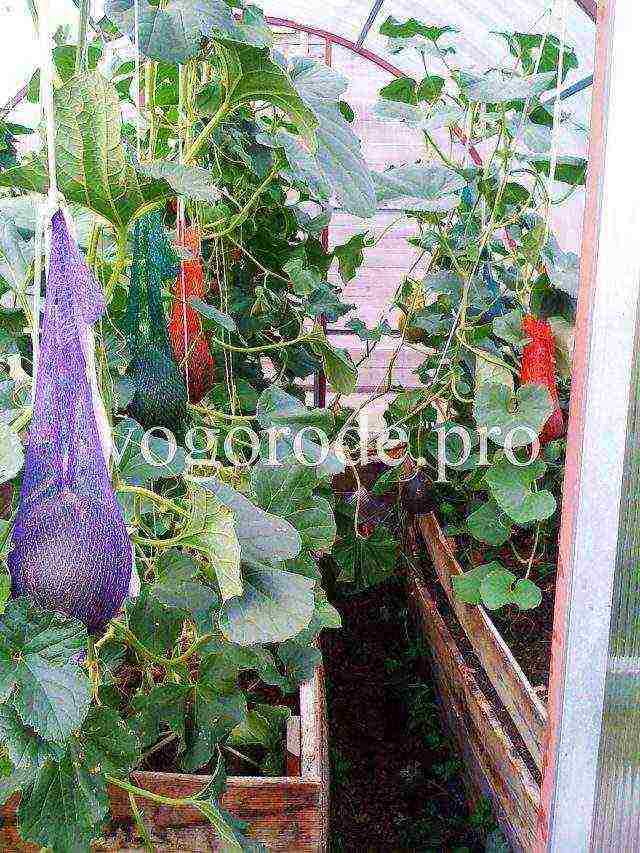 Melons grow in my greenhouse, in a vertical culture in the central garden, where the tomatoes grow.
Melons grow in my greenhouse, in a vertical culture in the central garden, where the tomatoes grow.
The requirements for air and soil moisture are similar.
In an ungrafted crop, the yield is about 5 melons weighing 1.5 kg per bush, in a grafted crop - 10 melons.
Melons, like cucumbers, can be grafted onto the stock, depriving them of their own, weak root system. Due to this, cold resistance is additionally increased, but the main thing is that the yield doubles! Melon care is quite simple, it does not like excess moisture, like a tomato, as well as excess organic matter in the soil, it needs more frequent watering only during the period of fruit growth. The most important thing at the initial stage is to correctly form the bush. About melon grafting... About the formation and care of melon bushes, I wrote in detail HERE
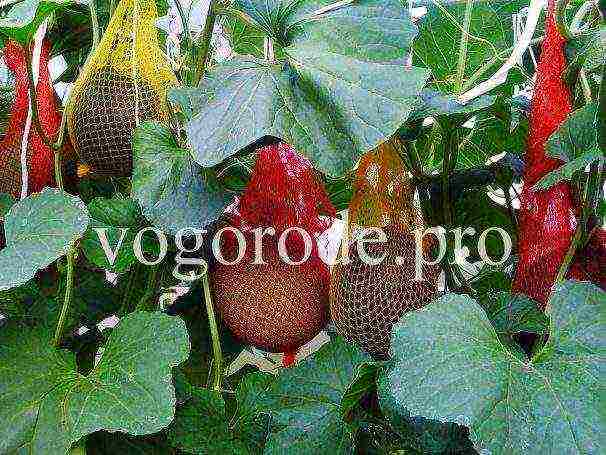 Melon harvest in a greenhouse, Leningrad region
Melon harvest in a greenhouse, Leningrad region
Growing watermelons in the open field. Leningrad region
Although I live in the north of the Leningrad Region, I grow watermelons in the open field.
For watermelons, a high bed with a height of 60 cm was made.
The soil is the earth with sand. Compost is applied only to the planting holes, no manure, because the fruits of watermelons, with a large amount of nitrogen in the soil, accumulate nitrates.
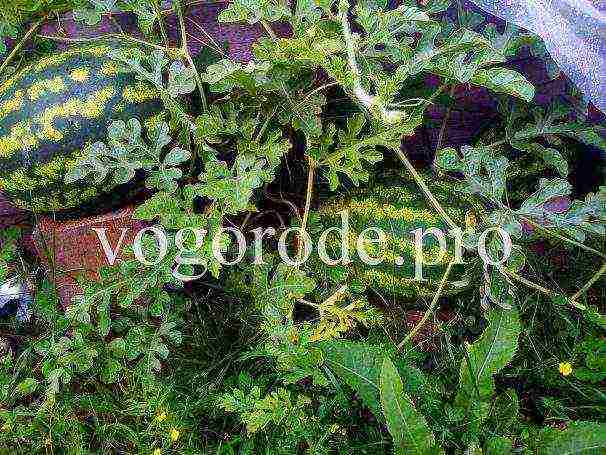 There, under arcs with non-woven material, the most delicious and sweetest harvest grows - watermelons, grow up to 8 kg in weight, about 3-5 pieces per plant.
There, under arcs with non-woven material, the most delicious and sweetest harvest grows - watermelons, grow up to 8 kg in weight, about 3-5 pieces per plant.
I also plant grafted watermelons. One of the reasons is that in a grafted culture, plants can be planted in the same bed from year to year, because the lagenaria used for rootstocks does not get sick with anything. The watermelons themselves are very prone to Fusarium disease, and stable cold weather within one to two weeks after planting the plants is guaranteed to develop this disease on the plants.
I carry out vaccination and care for watermelons as in the article “Watermelons in the Moscow region ".
Perhaps you have a plot not in a swamp, not a peat bog, but sand, and there are no problems with the "flooding" of the site during strong doges, but even in this case, in our northern, cold region, high beds will only increase your yield. After all, they will accumulate heat in themselves, like stoves, during the day, and give it to plants at night, because there are practically no warm nights in our region!
I will answer your questions in the comments.
St. Petersburg.
The role of agriculture in the country's economy can hardly be overestimated, since it is the main branch of the agro-industrial complex, which produces food products for the country's population, as well as raw materials for processing in other industries. But the main task of agriculture is to meet the needs of the population for food.
Different regions of the country specialize in the production of different agricultural products.The focus and specificity of each region, first of all, depends on the geographic location, which means on the climatic conditions in a particular zone.
For example, agriculture in the Leningrad Region is represented mainly by dairy farming, potato farming, poultry farming, and here, as in other regions of the country, more than half of the demand for consumer goods is satisfied by agricultural resources. Agriculture (including the Leningrad Region) is the main supplier of raw materials for food, feed, light industry and other sectors of the economy.
On the other hand, for example, agriculture in the Leningrad region is a large consumer of industrial goods. The industry supplies equipment for the needs of the village: cars, trucks, tractors, combines, equipment, as well as fuels and lubricants, compound feed and mineral fertilizers. According to statistics, the share of industrial goods in the structure of costs for agricultural production is almost 40%, therefore, the development of individual industries depends significantly on agriculture, and, in turn, the successful development of industry determines the effective functioning of agricultural producers.
Like any other sector of the national economy, agriculture also has some characteristic features that must be taken into account when carrying out entrepreneurial activities in this sector. For example, the agriculture of the Leningrad region, its structure, the level of development of certain areas directly depends on the soil and climatic conditions inherent in the area. Therefore, the grain yield, for example, in this region will differ from the yield in the North Caucasus region of the country. Also, due to the clear dependence of the results of activities in this sector of the national economy on natural conditions, there are certain risks in agriculture.
In agriculture, land acts as the main means of production. Unlike other means of production, land does not wear out when used correctly and can retain its qualities. But land resources can differ dramatically in fertility, as well as location, which leads to differential rent: producers with better conditions (soil, proximity to sales markets) can make a profit.
Living organisms act as specific means of production in agriculture: these are animals and plants that develop according to biological laws.
The specificity of agriculture also lies in its dispersal in various climatic conditions, which determines the selection of crop varieties, animal breeds, as well as the mechanization of individual production processes in agriculture and land reclamation. In addition, the method of chemicalization of agriculture also depends on the specifics of the soils in a given region.
A feature of agriculture as a branch of the economy is seasonality. Since some crops ripen and grow only at certain times of the year, the seasonality of agricultural work is especially noticeable when growing, for example, winter grain crops. The difference between the production time, on the one hand, and the working period, on the other, is clearly manifested in the production of these crops. After all, the period of growing winter cereals begins, as a rule, in July-August, with preparation and sowing, and only in July of the next year ends with the harvest. During this time, the preparation of the fields, sowing, fertilization and care of the crop, harvesting takes place - that is, the working period is resumed several times, while the production period continues continuously and represents the growth and development of plants, and is determined by natural natural conditions.
Crop production in the Leningrad region
Crop production in the Leningrad Region produces 35.5% of the total crop production in the Northwestern Federal District, as well as 1.3% of all RF production.
The Leningrad region, in accordance with its geographical location, is located in the zone risky farming... The total area of agricultural land in the region is 1703.3 thousand hectares. This category is dominated by forest lands - 848.5 thousand hectares (49.8%), agricultural production employs 617.6 thousand hectares (36.3%), including 359.9 thousand hectares (58 , 3%) of arable land.
Modern plant growing in the Leningrad Region is focused on the introduction of innovative technologies aimed at preserving and increasing soil fertility; increasing the level of crop production; reducing the dependence of agricultural production on the influence of unfavorable natural and climatic conditions; increasing labor productivity and mechanization of labor-intensive processes.
In the structure of the total sown area of the Leningrad Region, most of it is forage crops - 164.0 thousand hectares or 72%. Perennial herbs 90% of fodder crops are occupied.
Total sown area potatoes in all categories of farms is about 16.2 thousand hectares. Most of the cultivated areas of potatoes are concentrated on personal subsidiary plots. Agricultural enterprises and farms grow potatoes on an area of 5.1 thousand hectares (31%).
Vegetable growing in the Leningrad region is represented by open and protected soil. The area of open ground vegetables is 7.6 thousand hectares. The main volumes of vegetables are grown in 10 enterprises of the suburban area.
The main directions of crop production in the Leningrad region - potato growing and vegetable growing.
A significant part of the harvest of potatoes and vegetables is provided by personal subsidiary plots of the population. The main vegetable crops are cabbagecarrotcucumbersonionbeet... Grain crops are also grown in the region.: barley, rye, oats, mainly for livestock and poultry feed. Animal feed is produced in feed mills. There are 6 large feed mills in the region. The largest of them Gatchina feed mill.
The priority role in meeting the needs of the population for fresh vegetables during off-season in our region belongs to greenhouse vegetable growing... In protected ground in all categories of farms, about 52 thousand tons of vegetables are produced - cucumbers, tomatoes, peppers, eggplants, green crops.
Protected ground products in the Leningrad Region are represented not only by vegetables. Year-round production of champignon mushrooms has been mastered in "Prinevskoye" on an area of 0.636 hectares. The volume of production of champignon mushrooms is 1.2 thousand tons per year. In a small volume, oyster mushrooms are grown in the region, the producer is, Gatchina region (150-200 tons per year).
In recent years, the protected soil industry has been successfully developing in the Leningrad Region - floriculture... Holland ”, grow roses and potted flowers on an area of about 16.3 hectares. During the year, these enterprises grow about 30 million roses.
Many enterprises are engaged in the cultivation of vegetables in the Gatchina region, for example:
1. Belogorka "
Types of products:
Leaf lettuce
Green vegetable crops
Cabbage
Watercress
Bulbous vegetable crops
Mushrooms
2.SU OPH "Suida"
Types of products:
Cereals and legumes
Potato
Table root and tuber crops with a high starch or inulin content
Crop production in the Leningrad region
Crop production in the Leningrad Region produces 35.5% of the total crop production in the Northwestern Federal District, as well as 1.3% of all RF production.
The Leningrad region, in accordance with its geographical location, is located in the zone risky farming... The total area of agricultural land in the region is 1703.3 thousand hectares.This category is dominated by forest lands - 848.5 thousand hectares (49.8%), agricultural production employs 617.6 thousand hectares (36.3%), including 359.9 thousand hectares (58 , 3%) of arable land.
Modern plant growing in the Leningrad Region is focused on the introduction of innovative technologies aimed at preserving and increasing soil fertility; increasing the level of crop production; reducing the dependence of agricultural production on the influence of unfavorable natural and climatic conditions; increasing labor productivity and mechanization of labor-intensive processes.
In the structure of the total sown area of the Leningrad Region, most of it is forage crops - 164.0 thousand hectares or 72%. Perennial herbs 90% of fodder crops are occupied.
Total sown area potatoes in all categories of farms is about 16.2 thousand hectares. Most of the cultivated areas of potatoes are concentrated on personal subsidiary plots. Agricultural enterprises and farms grow potatoes on an area of 5.1 thousand hectares (31%).
Vegetable growing in the Leningrad region is represented by open and protected soil. The area of open ground vegetables is 7.6 thousand hectares. The main volumes of vegetables are grown in 10 enterprises of the suburban area.
The main directions of crop production in the Leningrad region - potato growing and vegetable growing.
A significant part of the harvest of potatoes and vegetables is provided by personal subsidiary plots of the population. The main vegetable crops are cabbagecarrotcucumbersonionbeet... Grain crops are also grown in the region.: barley, rye, oats, mainly for livestock and poultry feed. Animal feed is produced in feed mills. There are 6 large feed mills in the region. The largest of them Gatchina feed mill.
The priority role in meeting the needs of the population for fresh vegetables during off-season in our region belongs to greenhouse vegetable growing... In protected ground in all categories of farms, about 52 thousand tons of vegetables are produced - cucumbers, tomatoes, peppers, eggplants, green crops.
Protected ground products in the Leningrad Region are represented not only by vegetables. Year-round production of champignon mushrooms has been mastered in "Prinevskoye" on an area of 0.636 hectares. The volume of production of champignon mushrooms is 1.2 thousand tons per year. In a small volume, oyster mushrooms are grown in the region, the producer is, Gatchina region (150-200 tons per year).
In recent years, the protected soil industry has been successfully developing in the Leningrad Region - floriculture... Holland ”, grow roses and potted flowers on an area of about 16.3 hectares. During the year, these enterprises grow about 30 million roses.
Many enterprises are engaged in the cultivation of vegetables in the Gatchina region, for example:
1. Belogorka "
Types of products:
Leaf lettuce
Green vegetable crops
Cabbage
Watercress
Bulbous vegetable crops
Mushrooms
2.SU OPH "Suida"
Types of products:
Cereals and legumes
Potato
Table root and tuber crops with a high starch or inulin content
The role of agriculture in the country's economy can hardly be overestimated, since it is the main branch of the agro-industrial complex, which produces food products for the country's population, as well as raw materials for processing in other industries. But the main task of agriculture is to meet the needs of the population for food.
Different regions of the country specialize in the production of different agricultural products. The focus and specificity of each region, first of all, depends on the geographic location, which means on the climatic conditions in a particular zone.
For example, agriculture in the Leningrad region is represented mainly by dairy farming, potato growing, poultry farming, and here, as in other regions of the country, more than half of the demand for consumer goods is satisfied by agricultural resources. Agriculture (including the Leningrad Region) is the main supplier of raw materials for food, feed, light industry and other sectors of the economy.
On the other hand, for example, agriculture in the Leningrad region is a large consumer of industrial goods. The industry supplies equipment for the needs of the village: cars, trucks, tractors, combines, equipment, as well as fuels and lubricants, compound feed and mineral fertilizers. According to statistics, the share of industrial goods in the structure of costs for agricultural production is almost 40%, therefore, the development of individual industries depends significantly on agriculture, and, in turn, the successful development of industry determines the effective functioning of agricultural producers.
Like any other sector of the national economy, agriculture also has some characteristic features that must be taken into account when carrying out entrepreneurial activity in this sector. For example, agriculture in the Leningrad region, its structure, the level of development of individual areas directly depends on the soil and climatic conditions inherent in the area. Therefore, the grain yield, for example, in this region will differ from the yield in the North Caucasus region of the country. Also, due to the clear dependence of the results of activities in this sector of the national economy on natural conditions, there are certain risks in agriculture.
In agriculture, land acts as the main means of production. Unlike other means of production, land does not wear out when used correctly and can retain its qualities. But land resources can differ dramatically in fertility, as well as location, which leads to differential rent: producers with better conditions (soil, proximity to sales markets) can make a profit.
Living organisms act as specific means of production in agriculture: these are animals and plants that develop according to biological laws.
The specificity of agriculture also lies in its dispersal in various climatic conditions, which determines the selection of crop varieties, animal breeds, as well as the mechanization of individual production processes in agriculture and land reclamation. In addition, the method of chemicalization of agriculture also depends on the specifics of the soils in a given region.
A feature of agriculture as a branch of the economy is seasonality. Since some crops ripen and grow only at certain times of the year, the seasonality of agricultural work is especially noticeable when growing, for example, winter grain crops. The difference between the production time, on the one hand, and the working period, on the other, is clearly manifested in the production of these crops. After all, the period of growing winter cereals begins, as a rule, in July-August, with preparation and sowing, and only in July of the next year ends with the harvest. During this time, the preparation of the fields, sowing, fertilization and care of the crop, harvesting takes place - that is, the working period is resumed several times, while the production period continues continuously and represents the growth and development of plants, and is determined by natural natural conditions.
Cucumbers are considered one of the most common vegetables in Russia. This culture is distinguished by its thermophilicity.Therefore, when growing cucumbers, you should adhere to the basic rules for growing vegetables using varieties suitable for a specific region of the Russian Federation. Today we will consider what are the best self-pollinated cucumbers for growing in the Leningrad region.
The best self-pollinated cucumber varieties for the Leningrad region
The climate in the Leningrad region is Atlantic-continental, cold and humid. It is especially cold in the east of the region. In July, the average temperature in the region warms up to 18 degrees. For this reason, cucumbers in this area are grown mainly in greenhouses.
Planting is always carried out by seedlings.
If you grow cucumbers in open areas, then they must be planted at the end of May, not earlier... For a rich harvest, it is recommended enrich the soil with nitrogen.
A solution from chicken manure is excellent as a fertilizer:
- Dilute 1 kg of dry manure in 5-7 liters of water.
- Leave to infuse for 3-5 days.
- Then dilute the settled mixture with 10-15 liters of water.
The resulting fertilizer should be fed to cucumbers. once every 2-3 weeks.
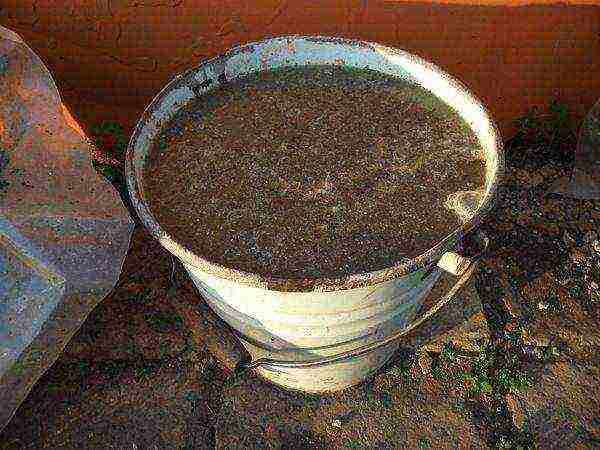 Chicken manure solution as fertilizer
Chicken manure solution as fertilizer
An important aspect in the cultivation of cucumbers in the Leningrad region is the choice of the variety. It is recommended for planting to choose seeds of domestic rather than imported producers, since such seeds tested in our climatic conditions... In addition, it is recommended to buy already proven brands of seeds in specialized stores, and not from individuals.
Should be given preference hybrid species, since the latter are more resistant to various diseases, as well as to cold climates.
Next, we will consider the most common self-pollinated ones, recommended for breeding in greenhouses and in open areas in the Leningrad region.
Greenhouse varieties
It is possible to plant cucumbers in the Leningrad Region both in capital polycarbonate, film greenhouses and in greenhouses.
Let us further consider which varieties of cucumbers are considered the best for growing in greenhouse conditions in the Leningrad region.
Erika
This mid-early hybrid is usually used for cultivation in film greenhouses on private household plots. This variety disease resistant.
The main characteristics of the species:
- The fruits are cylindrical in shape with wide tubercles, tender skin and covered with black thorns.
- Zelentsy reach up to 12 cm in length.
- The cucumber usually weighs 110-120 g.
- The pulp is not bitter, dense.
- The bushes of the plant are vigorous. In length they can reach up to 3.5 m.
Cucumbers are perfectly preserved and transported. Planting is carried out in May... If the soil is well warmed up, this species brings a stable rich harvest.
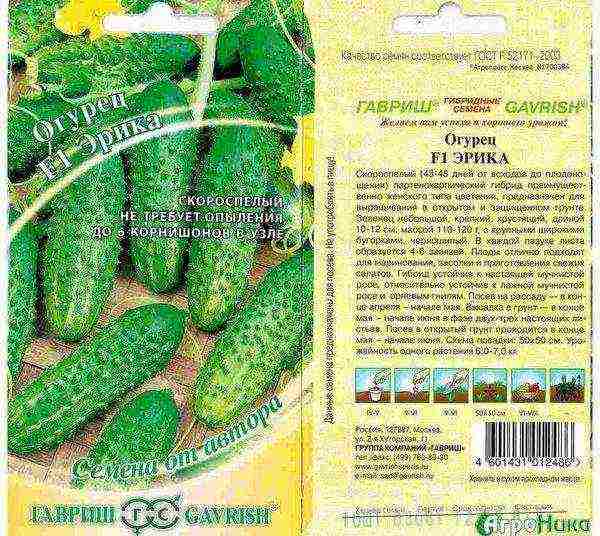 Erika
Erika
Juventa
Mid-season hybrid with good taste. Used for growing in winter and spring.
Characteristic features of the culture:
- the main stem grows up to 1.5 m long, not very branched;
- cylindrical cucumbers, up to 27cm long;
- the weight of the greens is usually 220-280g.
This variety resistant to root or root rot.
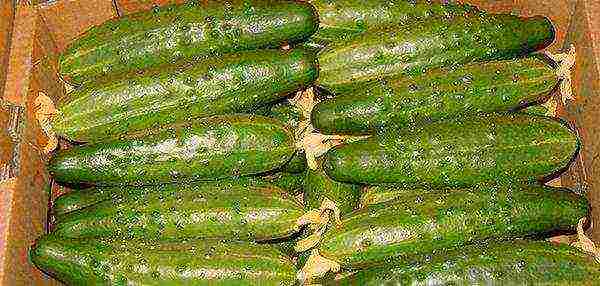 Juventa
Juventa
Our Dasha
The mid-season species is used for breeding in the spring-summer period in greenhouses with a film coating without heating.
Main characteristics:
- greens are long, cylindrical, covered with large tubercles;
- pulp of medium density, crispy, not bitter;
- fetal weight approximately 90 gram;
- bushes are weakly branched, vigorous.
This variety resistant to short-term temperature dropas well as many diseases.
Our Dasha
Emelya
This early ripening hybrid is highly productive and disease resistant.
It is used for growing in greenhouses with heating, and in film. The fruits are distinguished by their high taste. Zelentsy reach up to 15 cm in length and weigh on average 130-170g.
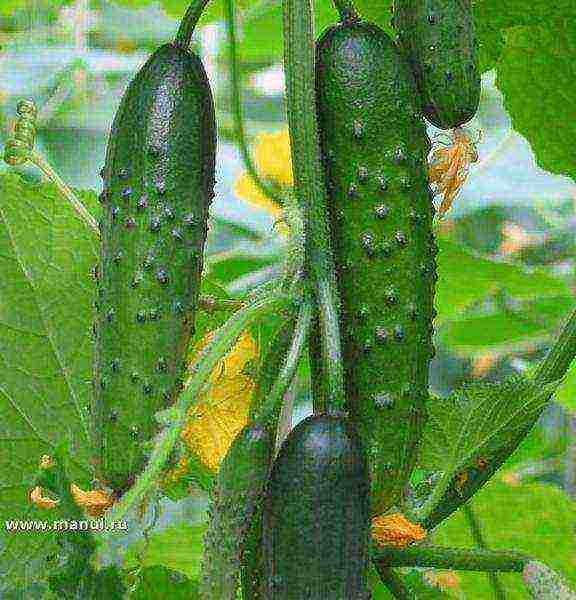 Emelya
Emelya
Zozulya
Quite a popular hybrid, characterized by good yield and disease resistance... Zelentsy Zozuli are of medium or large sizes. The mass of a cucumber is usually 280 grams. Bushes are medium-branched. The fruits are well preserved.
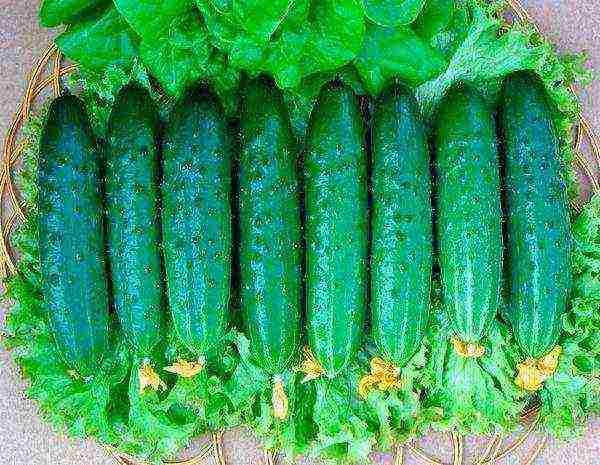 Zozulya
Zozulya
Tchaikovsky
An early hybrid. Zelentsy are covered with black thorns and small pimples. This culture is grown in both film and glazed greenhouses.
In addition to the above cucumbers on the territory of the Leningrad Region, the following varieties are perfect for growing in greenhouses: Lapland, Valaam, Karelian, Hercules, White Angel, Cupid, etc.
For open ground
The Leningrad Region is a very large region. Gardening rules differ in different parts of the region, for example in the south and north.
Cultivation of cucumbers in open areas in the northeastern part of the region is considered ineffective.
In the southern and central parts of the region, this type of vegetable growing is possible. Consider the most common varieties of cucumbers that gardeners use for growing outdoors in the Leningrad Region.
Madagascar
It is an early maturing hybrid with good taste. A significant part of zelents is formed on the main lash, which allows you to harvest fruits strictly on weekends... This is considered an important advantage for a large number of summer residents and gardeners.
Main characteristics:
- The fruits are cylindrical, not long.
- The weight of a cucumber is usually 90 g.
Zelentsy is widely used in canning, pickling, and also raw.
 Madagascar
Madagascar
The fast and the furious
It is considered one of the earliest ripening hybrid varieties. The plant will delight with the harvest later 38 days.
Characteristics:
- fruits of a dark green color of a cylindrical shape;
- greens are not large in size, up to 12 cm in length.
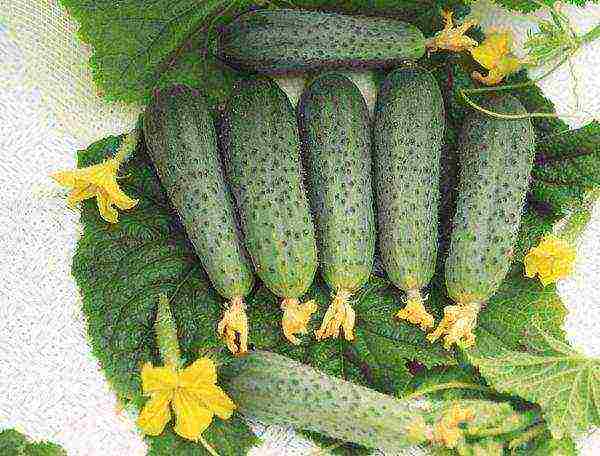 The fast and the furious
The fast and the furious
Openwork
This hybrid is characterized by a long fruiting period. Approximately after 40 days the plant gives the first harvest.
The variety is highly resistant to many diseases. Medium-branched bush. Zelentsy are small in size, up to 11 cm long.
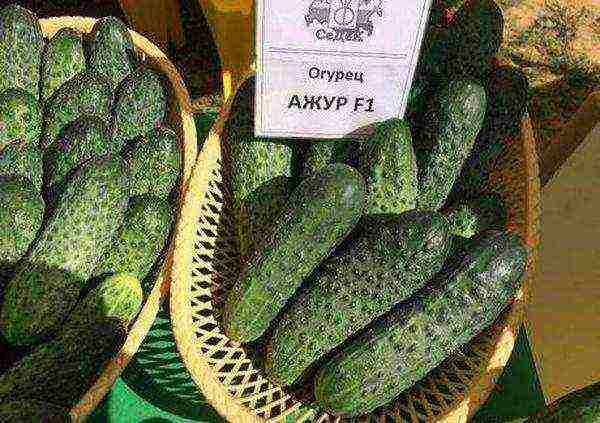 Openwork
Openwork
Athos
This mid-season, high yielding the hybrid is grown both in greenhouse conditions and in open areas.
Main characteristics:
- Zelentsy are dark green in color, with small tubercles.
- The variety bears fruit in small cucumbers up to 9 cm in length.
Crispy cucumbers. They are widely used both fresh and in canning.
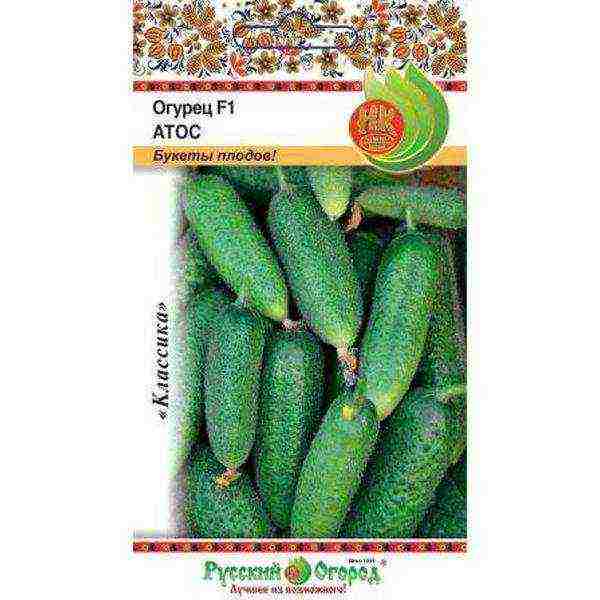 Athos
Athos
Claudius
This plant fast growingas well as resistance to most diseases. The fruits of the culture are cylindrical in shape, outwardly covered with black thorns up to 10 cm in length.
For growing cucumbers on open ground, in addition to the above varieties in the Leningrad Region, the following varieties are also used: Graceful, Cascade, Hector, Nugget and others.
Because of the climatic features in the Leningrad Region, it is not very easy to grow cucumbers. For a rich harvest, it is very important to select the varieties recommended for this region. On the territory of the Leningrad region, cucumbers are grown mainly in greenhouse conditions, and not in open areas.
What are regionalized varieties?
In the system of state testing of varieties, plots are organized on which varieties and hybrids bred by various institutions are grown from different places and on the basis of a competition they are evaluated according to yield, early maturity, suitability for processing, taste, resistance to pests and diseases, etc.
A variety or hybrid that has shown the best results by all indications is approved by the State Variety Testing Commission for zoning in a region with similar natural and climatic conditions.
The State Register of Breeding Achievements is annually supplemented and republished by the RF State Commission for Testing and Protection of Breeding Achievements. The varieties and hybrids included in it are preliminarily tested for two to three years in various regions of the Russian Federation.
Many varieties and hybrids of vegetable crops are imported to Russia by foreign companies, but they are not applicable to our soil and climatic conditions. Such seeds, as a rule, are not tested for infection by quarantine pests, diseases and weed seeds, as a result of which new infectious diseases, pests, etc. are introduced into the field, vegetable gardens, summer cottages.
Why is own seed production risky compared to the work of breeding research institutes and companies?
Some gardeners themselves are engaged in seed production of vegetable crops. They think so: they sowed the seeds of the variety they liked, got the fruits, brought them to biological ripeness, isolated the seeds, dried them - and that's it. And very often the seeds they receive, especially of cross-pollinated plants, do not correspond to the variety. Plants from such seeds are of low productivity, and the quality of products is unsatisfactory.
In fact, in the process of seed production, a number of important requirements must be strictly observed. Each variety has an originator: a research institution, a seed breeding company. Breeders maintain the variety throughout its existence.
Selecting the best plants in the control-elite nursery, they produce original seed material, which further multiplies under their strict authorial control to the elite and reproductive seeds. Along with breeders, the seed production process is also controlled by specialists from the Federal Service for Phytosanitary Supervision. They do not allow for sale seeds that do not correspond to the varietal purity and sowing qualities approved by the OST.
It should also be borne in mind that seed production of any variety is carried out with mandatory spatial isolation from another variety - in order to avoid cross-pollination. So, for cross-pollinated crops (cucumber, zucchini, onions, pumpkin, etc.), it must be at least 1000 m.It is simply impossible to comply with this requirement in the conditions of a summer cottage, a vegetable garden, a personal plot, as you yourself understand.
And some gardeners try to propagate hybrid plants, and, as a rule, this ends in failure. Why? The breeder obtains a hybrid (designation on the seed bag - F1) by crossing specially selected parental lines with the help of bees or manually. Only a hybrid derived from these lines has a heterotic effect. Its further reproduction, which is usually done by the gardener, leads to the loss of subsequent generations of almost all advantages. As breeders say, in the second and subsequent generations "the hybrid disintegrates."
Tips and tricks when buying seeds for planting
Purchase seeds of varieties and hybrids adapted (zoned) to the soil and climatic conditions of your region or bred by local breeding scientific institutions.
Buy seeds in the manufacturer's original packaging. When choosing seeds in a store, you need to pay attention to packing bags. Bright packaging is not a guarantee of quality. Often domestic seeds are packed in simple white paper bags, but they give a high quality, good harvest, as they are adapted to the conditions of our climate.
Before going to the store, you need to make a list of what to buy, because seeing a lot of beautiful bags, your eyes run up.
Do not buy seeds in dubious stalls, from sellers in the market who cannot provide you with documents certifying the varietal and sowing qualities of seeds.
It is necessary to pay attention to how the expiration date is stamped on the package. The date should indicate the year and month of sale, and it is better that they were stamped with ink, and not printed by typographic method, like all other information on the package.
Also, the sachet should indicate the name of the crop, variety or hybrid, characteristics of the appearance of the flower or fruit, the number or weight of seeds, their compliance with GOST, the coordinates of the manufacturer's company, the barcode of the country of the manufacturer, and the batch number. Often the bags contain additional advice on sowing and care and a photograph of the plant or fruit.
Sometimes gardeners and summer residents become buyers of counterfeit products, tempted by a low price. Fraudulent fly-by-night companies counterfeit packaging with a popular brand and put it there, no one knows what.
It is also useful to know that the quality of seeds from the CIS countries is not checked in laboratories in Russia, but are guided by certificates issued in these countries, while imported seed must be checked. Imported seeds packaged in Russia must have seed inspection documents, which, with the slightest doubt, can and should be asked from the seller.
Imported seeds must be accompanied by translated sowing and growing instructions and must be suitable for our climate zone.
It is very rare to see the percentage of seed germination on the package. But the seller must have a quality certificate, the seller must give such information based on the indication of the batch number.
After purchasing the seeds, keep the receipt, and after sowing them, save the bag. The presence of both makes it possible to present a claim to the seller later.
You should be aware that you should not collect seeds from hybrid plants for the next season, as they do not retain their parental properties. First-generation hybrid varieties are commercially designated F-1, F-2 stands for second-order hybrid. Second generation hybrids not only have a lower cost, but also yield lower yields.
To purchase as much seed as you need, you can use the following calculation rates: for 10 m2 of area you need: white cabbage 12-15 gr., Tomatoes and peppers 2-3 gr., Cucumbers 6-8 gr., Pumpkin 3-4 gr., Watermelon 2-3 gr., Melons 1.5-2 gr., Onion-nigella 6-10 gr., Garlic 500-600 gr., Carrots 4-6 gr., Parsley 8-10 gr., Beetroot 10-12 gr., radish 17-23 gr., potatoes 2.5-4 kg, beans 90-150 gr., spinach 24-60 gr., dill 30 gr.
What varieties of vegetables are zoned for the Leningrad region?
Below are just some of the zoned varieties. This list is far from complete.
Regionalized varieties of tomatoes for the Leningrad region
for whole-fruit canning - plum-like, early-ripening varieties - Shuttle, Finger, Spout
for fresh consumption with high resistance to late blight - Grotto, Cameo, Dubok, Gnome, Grand, Gaia
lettuce, early ripening varieties with a raspberry color of the fruit - Lotus, Lakomka, Malinka (it has proven itself well in film greenhouses), Ilya Muromets, Rassvet F1;
orange-fruited varieties - Charovnitsa (suitable for film greenhouses), Spout, Dewdrop
early maturing standard varieties - Argo, Chelnok, Finger, Evgenia
Regionalized varieties of cucumbers for the Leningrad region
Greenhouse varieties: Abundant F1, Brother Ivanushka, Marinda, Murashka, Liliput, Hercules F1, Amur F1, White Angel F1;
For open ground: Nugget, Altai early, Cascade, Rural fair, Hector F1, Voyage F1, Graceful.
Zoned zucchini varieties for the Leningrad region
Anchor, Gribovskie, Long-fruited. Zucchini squash is distinguished by its early maturity, high yield (up to 20 fruits per plant), good nutritional value and keeping quality. Zucchini varieties: Aeronaut, Zebra, Golden.
Zoned eggplant varieties for the Leningrad region
Eggplants: early maturing - Dwarf early, Early maturing, Universal
Mid-season - Dnestrovets, Donskoy, Almaz
Regionalized pumpkin varieties for the Leningrad region
Among its varieties, the most "in use" among gardeners are large-fruited Canteen winter, Volzhskaya gray, Marble, Tverdokorya, Almond, Mozolevskaya.
Regionalized varieties of carrots for the Leningrad region
Rogneda, Incomparable and Shantenay have proven themselves well.
Zoned beet varieties for the Leningrad region
Beetroot. Bordeaux, Havskaya. A distinctive feature of Khavskaya is that it is one-sprout. The variety is fruitful, good taste. The Podzimnyaya variety can be sown late in the fall, before winter.
Regionalized onion varieties for the Leningrad region
Onion varieties: spicy (for cooking) - Arzamas local, Bessonovsky local, Golden Semko, Mstersky local, Penza, Stuttgarten rizen, etc.
peninsular - Volgodonets, Danilovsky-301, Kaba, Karatalsky, Myachkovsky - 300, Odintsovets, Early Pink, etc.
sweet (for salads) - Spanish - 313, Orange, Exhibit, etc.
Regionalized varieties of radish for the Leningrad region
Recommended varieties of radish: Pink-red, with a white tip, sown at the earliest possible date, as well as Zhara, Zarya, Saksa, Red giant - late ripening varieties.
Zoned radish varieties for the Leningrad region
Radish: the best variety of early ripening - Maiskaya (white); for late autumn and winter consumption - the Winter Black variety, it is high-yielding and well stored.
Regionalized varieties of beans for the Leningrad region
Beans: sugar varieties - Saksa without fiber, Sugar Triumph, Belosemyannaya; shelling varieties - Gribovskaya, Moskovskaya Belaya, Schedraia.
Zoned pea varieties for the Leningrad region
Sugar varieties - Inexhaustible, Early Gribovsky; shelling varieties - Emerald, Alpha, Vegetable grower.
Regionalized varieties of parsley for the Leningrad region
Sugar root, Bordeaux-Vickian root, Common leaf, Curly leaf.
Zoned varieties of dill for the Leningrad region
Gribovsky, Kibray - are distinguished by high yield of greenery.

